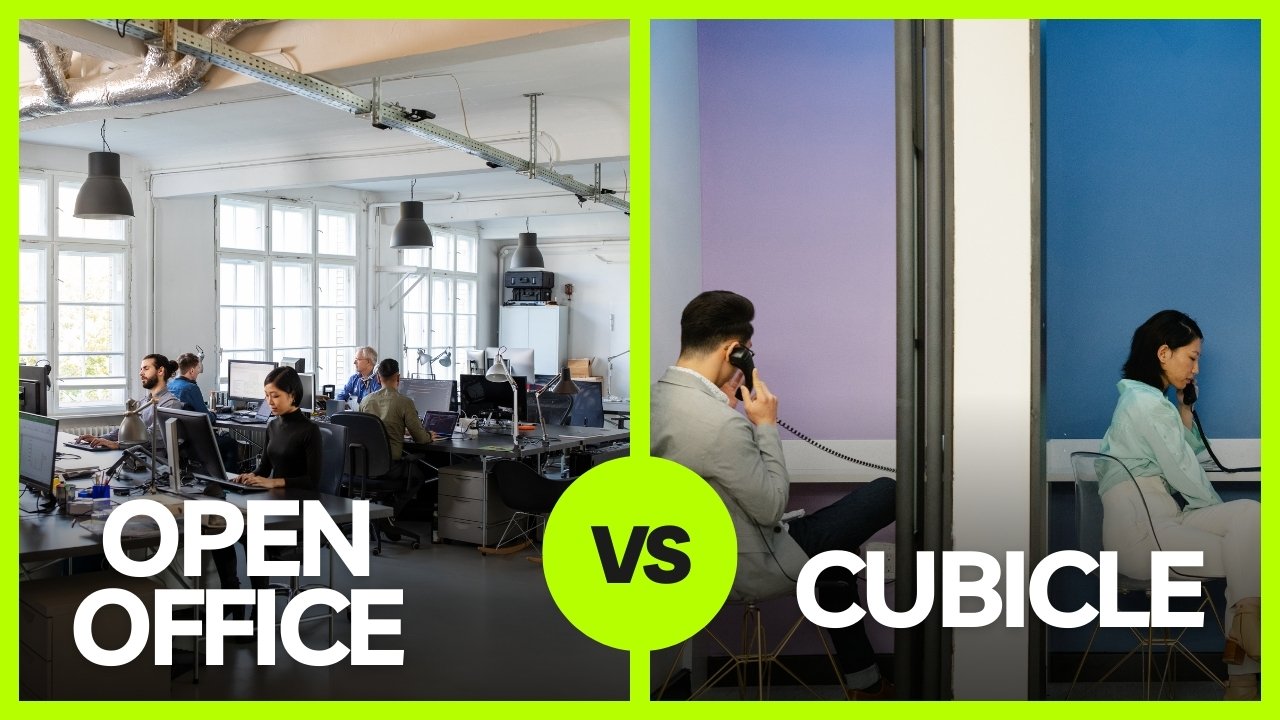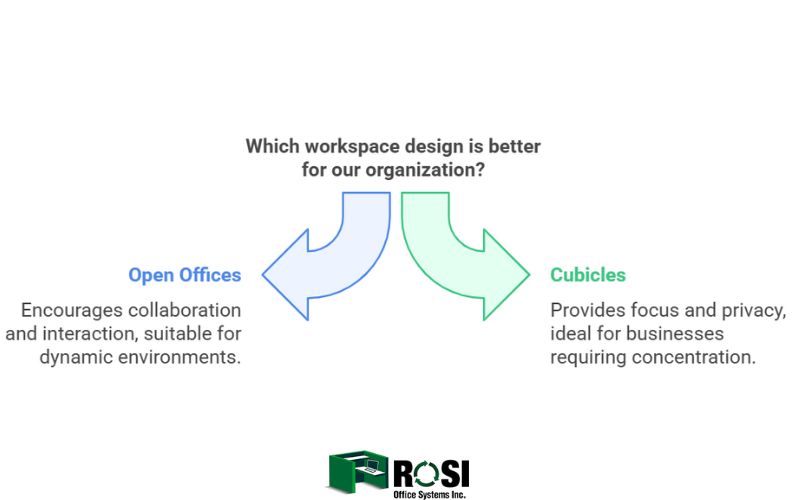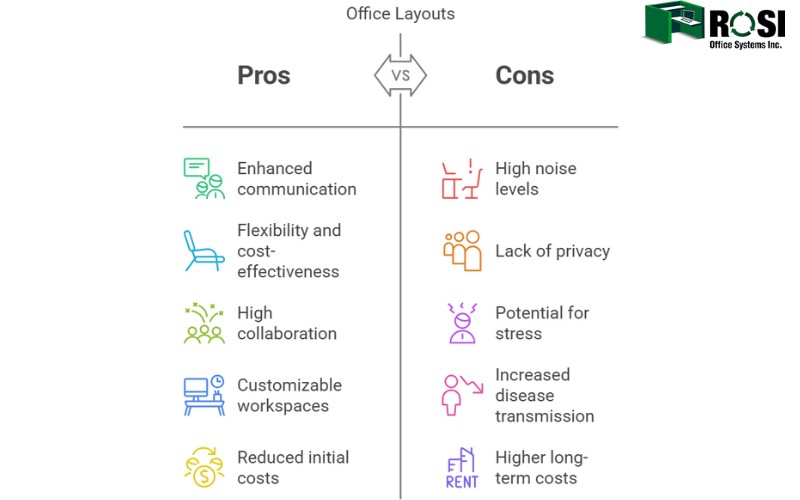
One of the most controversial decisions in business today is choosing between open offices and cubicles.
Cubicle advocates emphasize focus, privacy, and reduced distractions, while open-office proponents argue that open-concept offices increase collaboration and interaction among colleagues.
Open-Office vs. Cubicle: Which Is Better? Open offices promote collaboration, flexibility, and a modern aesthetic but can be noisy and distracting. Cubicles provide privacy, reduce noise, and enhance focus but may feel isolating. The best choice depends on workplace needs open spaces suit teamwork, while cubicles are ideal for concentration and individual productivity.
In this article, we will compare these two design styles and examine factors such as productivity, team interactions, privacy, and employee satisfaction to help you make the best choice for your workplace.
What is an Open-Office Layout?
Open offices are a type of layout in which tall walls and dividers, private offices, and cubicles are eliminated.
It is a shared workspace style without physical barriers that promotes collaboration and interaction.
These offices typically feature group work desks, adjustable chairs, and comfortable seating.
Due to the absence of physical barriers, communication is clearer and information is exchanged more quickly.
This type of layout is very popular in tech companies and startups.
Many tech companies like Google, Facebook, Apple, and Amazon use open-office designs to encourage innovation and collaboration among their employees.
The idea first came about in the 1950s, with companies like Herman Miller starting to design open offices.
What is a Cubicle Workspace?
In a cubicle layout, each employee’s workspace is separated from the rest of the office by short walls and dividers.
Cubicles provide a semi-private space for individuals, a balance between a fully open layout and private offices.
These walls reduce distractions while allowing for communication between employees.
In a private cubicle, privacy is maintained and employees can focus on their tasks without being disturbed by their colleagues.
Private office cubicles can be personalized and decorated with decorative items and plants.
However, some employees may find the cubicle space too closed and boring.
Open-Office Versus Cubicle: 5 Comparision
1. Productivity and Efficiency
Designing an office space can yield different results depending on the type of work and the needs of employees.
In open work environments, communication between team members is easier and faster.
Employees can easily share new ideas and collaborate on projects.
Open environments are usually more suitable for creativity and teamwork because constant communication between employees can lead to the formation of new ideas and faster problem-solving.
Many technology companies and startups use open offices because of this feature.
Therefore, open offices are very efficient for businesses such as marketing teams or call centers.
Cubicles provide separate workspaces that are ideal for jobs that require focus and a lack of distractions.
For jobs that require high levels of concentration and a quiet environment, such as programming, finance, and accounting, cubicles can greatly impact productivity.
The walls of cubicles, even if short, provide employees with a level of privacy.
In cubicle environments, employees typically have more freedom to arrange their desks.
They can customize their cubicle to suit their personal needs and tastes, which can help increase their satisfaction and comfort.
You Might Also Enjoy: How Much Does It Cost To Move Office Furniture: 2025 Update
2. Privacy and Noise Levels
In open offices, noise pollution is very high due to the lack of physical barriers.
Calls and meetings with colleagues can all pose challenges for people whose jobs require concentration and a quiet environment.
It is also more difficult to maintain information security and carry out confidential work in such environments.
On the other hand, cubicle environments have a quieter and more personal atmosphere and reduce the amount of ambient noise.
This type of design increases employee concentration and prevents visual and audio distractions, so they can focus on their work without worrying about disturbances from the surroundings.
Also, in some companies, soundproofing equipment is used in cubicle walls to minimize noise levels.
3. Collaboration and Communication
One of the most prominent features of open offices is the high level of interaction and collaboration between individuals.
In open offices, access to managers and colleagues is easier, and teams can hold formal meetings quickly and without the need for time-consuming coordination.
These spaces allow people to easily ask questions and share their ideas.
On the other hand, cubicle spaces have an isolated environment that reduces employee interaction.
In this type of workspace, communication is done via email and instant messaging, and discussions and team collaboration require scheduled meetings.
This can, in some cases, reduce creativity and slow down group decision-making.
4. Employee Well-Being and Satisfaction
It is true that open offices have many benefits and enhance interaction and collaboration between colleagues, but constant exposure to noise and other people’s activities can increase stress.
Also, the lack of privacy and the possibility of frequent distractions can lead to mental fatigue and reduced productivity.
In terms of physical health, open workspaces are also more likely to transmit diseases in the environment due to the shared use of space and equipment.
In cubicle workspaces, privacy brings focus and relaxation, and people perform their tasks with less stress.
This feature can increase the feeling of comfort and satisfaction of employees.
However, in such an arrangement, if communication between employees is not managed properly, it can lead to a feeling of isolation in individuals and limit communication between colleagues.
5. Cost Considerations
Since open office layouts are more flexible and require less office furniture, they can be a cost-effective option for many businesses.
You can also use multifunctional and modular office furniture in open-office workstations to optimize space.
By eliminating walls and physical barriers, open office layouts allow more employees to fit into a limited space.
This makes more efficient use of space and reduces rental and maintenance costs.
In addition, using an open layout can reduce other costs, such as energy consumption for lighting and ventilation.
Cubicles, on the other hand, take up more space.
Purchasing and installing separate cubicles, desks, dividers, and proper ventilation systems increases the initial costs.
Compared to open offices, cubicles are less flexible in layout and require additional costs if changes are needed.
In addition, more space per employee may lead to higher office rental and operating costs in the long run.
You Might Also Enjoy: What Are The Best Brands Of Office Furniture In 2025
Hybrid Office Solutions
In recent years, many businesses have moved towards hybrid office designs to balance the different needs of their employees.
This design combines open spaces and private cubicles so that employees can benefit from the advantages of both models.
This type of hybrid space both increases the possibility of interaction and collaboration between employees and provides space for concentration and independent work.
Flexibility in the allocation of workspace is also a prominent feature of hybrid office design.
For example, someone who needs high concentration can use a private cubicle, while someone who needs group meetings can benefit from an open and collaborative space.
By creating a balance between group interactions and private space, the hybrid layout model helps increase productivity, employee satisfaction, and flexibility in the office workplace.
Given the changes in the world of work and the increase in remote work, the use of hybrid office design is increasingly welcomed and will shape the future of office design.
Which is Better?
Both open office spaces and cubicles have their own advantages and disadvantages, so choosing an office layout is a very important and challenging decision.
Open design encourages more interaction, creativity, and speed of work.
On the other hand, it brings problems such as noise and distraction.
Cubicles also provide a quiet and distraction-free environment for employees, but they limit collaboration and sharing of ideas.
To make the best choice, you need to consider the organizational culture, type of business, and employee needs so that everyone can perform at their best.
Ultimately, a hybrid layout may be the best solution for modern offices.
This approach can combine the advantages of both models and provide employees with a flexible space that suits their different needs.

John Ofield is a recognized expert in the office furniture and office cubicle industry, with over 40 years of experience. As the founder of ROSI Office Systems, he specializes in space planning, custom cubicle designs, and high-quality commercial furniture. John’s expertise helps businesses enhance productivity and collaboration. He is also dedicated to mentoring entrepreneurs and redefining workspaces to inspire success.




